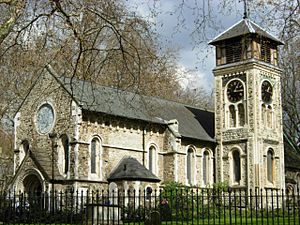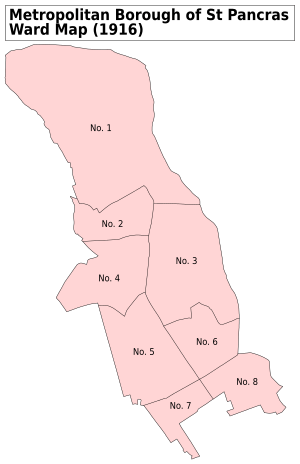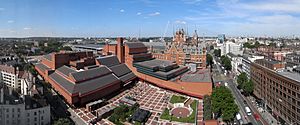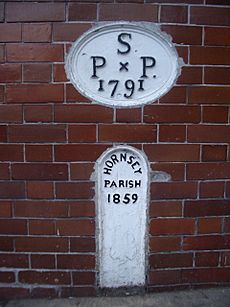St Pancras, London facts for kids
Quick facts for kids St Pancras |
|
|---|---|
 St Pancras New Church, Euston Road. |
|
| OS grid reference | TQ305825 |
| London borough | |
| Ceremonial county | Greater London |
| Region | |
| Country | England |
| Sovereign state | United Kingdom |
| Post town | LONDON |
| Postcode district | WC1 |
| Postcode district | NW1 |
| Dialling code | 020 |
| Police | Metropolitan |
| Fire | London |
| Ambulance | London |
| EU Parliament | London |
| UK Parliament |
|
| London Assembly |
|
St Pancras (/ˈpæŋkrəs/) is a district in central London. It started as an old church area in the Middle Ages. Later, it became a larger local government area. Today, the area it covered makes up about half of the London Borough of Camden. St Pancras includes well-known places like Camden Town, Kentish Town, King's Cross, and Fitzrovia.
History of St Pancras
St Pancras Old Church
St Pancras Old Church is a very old church located near St Pancras railway station. It is named after Saint Pancras, a Roman martyr. The church gave its name to the entire St Pancras district.
Many people believe this church is one of the oldest Christian worship sites in England. It was mentioned in the Domesday Book in 1086, which shows it was already old by then.
Over time, a new church, St Pancras New Church, was built in 1822 on Euston Road. The Old Church continued to be used but became a smaller, local church. Most of what you see of the Old Church today was rebuilt in the Victorian era.
Old Parish Area
The old parish of St Pancras was set up in the Middle Ages. A parish is an area served by a church. This parish covered five main areas, including Kentish Town, Tottenham Court, and Chalk Farm.
As London grew, the population of St Pancras also grew a lot. By the late 1800s, the old parish was divided into 37 smaller church areas. This helped serve the many new residents.
Before City Growth
For a long time, St Pancras was a quiet, rural area with people living far apart. It was not a busy city place. Famous playwright Ben Jonson often mentioned the area in his plays. This was before London started to expand rapidly in the late 1700s.
City Development
In the 1790s, Earl Camden began to develop land north and west of the old church. This area became known as Camden Town. Around the same time, a new housing area called Somers Town was built to the south and east.
In 1822, the new St Pancras church was opened. It was built on what was then called the New Road, now Euston Road. This road was London's first major bypass, like a very early version of the M25. The new church is famous for its Greek Revival style.
In the mid-1800s, two major railway stations were built in the area: King's Cross and St Pancras. The new church is also close to Euston station.
Local Government
The local government for St Pancras was run by a group called a "vestry" until 1900. Then, the Metropolitan Borough of St Pancras was created. A "borough" is a type of local district.
In 1965, the St Pancras borough joined with two other boroughs. Together, they formed the London Borough of Camden, which is how the area is governed today.
In the 1950s, the St Pancras Council had strong political views. They disagreed with some government policies, especially about housing. This led to some disagreements and changes in the local council.
St Pancras Battalions
From 1859 to 1955, St Pancras had its own military units. These were groups of soldiers from the area who joined the British Army. Many of these soldiers came from working-class parts of St Pancras, like Camden Town.
During World War I, these units became known as the St Pancras Battalions. They were part of the London Regiment. Because so many people joined, the main battalion split into several smaller ones. One special group was called the "St Pancras Pals." These were friends who joined the army together.
These battalions fought in important battles during World War I. They served on the Western Front in France and Belgium, and also in other places like the Macedonian front and the Sinai and Palestine Campaign. One soldier, Sergeant Burman, even won a Victoria Cross for his bravery in 1917.
Geography of St Pancras
St Pancras was originally an old parish area. It stretched from just north of Oxford Street all the way up to part of Highgate. It also went from Regent's Park in the west to York Way in the east. These old boundaries cover a large part of the modern London Borough of Camden.
The old River Fleet formed part of its boundary with Clerkenwell. Another stream, called Lamb’s Conduit, marked the southern boundary. The area also includes the famous Gospel Oak district, named after a tree that marked a boundary with Hampstead.
Transport in St Pancras
St Pancras is very important for London's transport system. It has three of the city's biggest train stations: Euston, St Pancras, and King's Cross. These stations are all located along Euston Road.
These stations were built on Euston Road because a special group in 1846 wanted to protect the West End from too much railway traffic.
National Rail stations like London King's Cross and St Pancras are here. St Pancras station is very famous and has been expanded. It is now the main station for Eurostar trains that travel through the Channel Tunnel to Europe.
The main London Underground station in the area is King's Cross St Pancras.
Landmarks in St Pancras
Just north of the St Pancras churchyard is St Pancras Hospital. This building used to be a workhouse, which was a place where poor people could live and work. Later, it became the London Hospital for Tropical Diseases.
Cemeteries in St Pancras
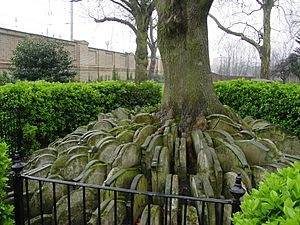
In the 1700s and 1800s, St Pancras was known for its many cemeteries. Besides the graveyard at Old St Pancras Church, there were also cemeteries for other nearby churches.
These cemeteries were closed in 1854. The parish then bought new land far away in East Finchley for its new St Pancras Cemetery.
The old graveyard at St Pancras Old Church was later disturbed when the Midland Railway was built. Many graves had to be moved. Thomas Hardy, who later became a famous writer, helped with this work. He arranged some gravestones around a tree, which is now called "the Hardy Tree."
The cemetery was disturbed again in 2002–03 when the Channel Tunnel Rail Link was built. However, this time, much more care was taken when moving the remains. Old St Pancras Church and its graveyard have connections to famous people like Charles Dickens, Thomas Hardy, and Mary Wollstonecraft.
Open Spaces in St Pancras
The district has several nice open spaces where people can relax and enjoy nature. These include:
|
|
Notable Residents
Many interesting people have lived in St Pancras over the years:
- Alice Barth, a singer
- Walter Alfred Cox, an engraver
- Ada Ferrar, an actress
- Monica Charlot, a historian
- Elizabeth Eiloart, a writer
- Beatrice Ferrar, an actress
- William Hartnell, an actor
- Barnaby Kay, an actor
- Andrew Lincoln, an actor
- Lulu Valli, an actress
- W. B. Yeats, a famous poet
Images for kids
See also
 In Spanish: St Pancras para niños
In Spanish: St Pancras para niños



